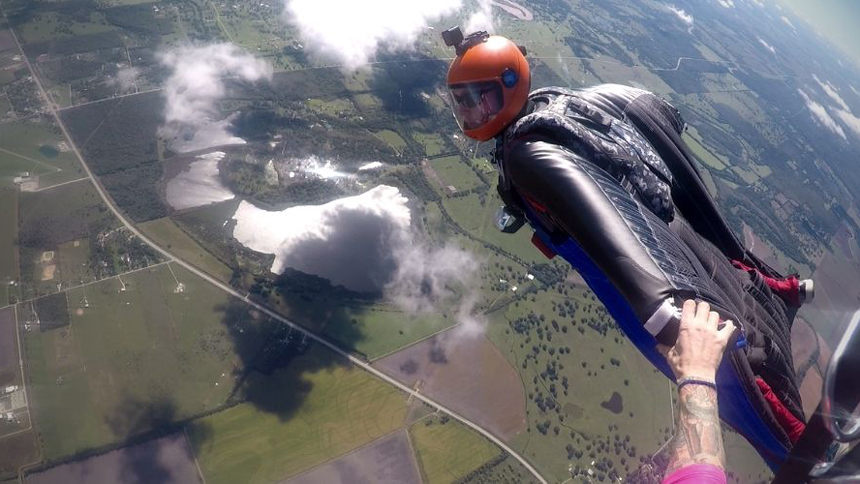The chilling account of a freak wingsuit collision…

…who doesn’t love a happy ending story?
Every skydive is built from many variables. Sometimes a CYPRES save is created by a freak occurrence with no conscious contribution from any human participant. Sometimes decisions are made at points along the way that affect the outcome.
In March of 2019 over Spaceland Dallas, Alex Ogden was knocked out following a collision with another jumper shortly after exit on an otherwise pretty straightforward wingsuit jump. Alex would then go into a prolonged and violent flat spin for the entire remaining vertical distance, only regaining consciousness after touching down under his reserve canopy in a Texas field.
Alex, can you give us a quick backround?
Alex: I started out skydiving with two tandems both on my birthday one year apart, when I turned 19 and then 20. After those first and second jumps I liked it so much that in 2015 I started AFF at Skydive Alabama. I finished up my A license at Spaceland Dallas which was still Skydive Dallas at the time.
I didn’t really start thinking about wingsuiting until I had around 125 jumps. Tracking was my thing. I started tracking with around 70 jumps and that was my focus until I hit 200. 225 was my first wingsuit jump in the Summer of 2018. From there, wingsuiting became my big thing. I like to concentrate fully on something when I am first starting out so I can work out the kinks and get good at it. Wingsuiting became pretty much the only thing I did after that.
The video… chilling…
So what happened?
Alex: I would start with the first jumper that gets out. It is easiest just to name them 1 through 4 as per the exit order. Jumper 1 at the time had 10 wingsuit jumps and I as jumper 2 only had about 50 – so pretty low numbers. The other 2 jumpers behind me both had several hundred wingsuit jumps and bigger suits so that was the exit order to avoid something like getting bumped on exit.
This accident happened on my 7th jump of the day. There had been a few people coming and going but the other two guys behind me had been the main group and we had been doing the same pattern all day. We had been doing a North jump run with a North, East, and South flight path, and it was the same for this jump.
Our plan was to fly up the jump run for a bit until everyone had got out before doing pattern stuff, but jumper 1 fumbles the exit, tumbles a bit losing awareness – and starts heading East right away. With me being the second jumper out, I see him going to the East so I am thinking I will try to head to the North East in his view to see if he recognises it is the wrong direction and then makes the change back to North and keep everyone together. He was not super low or anything – we could easily get to him. I have always been conservative and was not going to dive down – I would slowly approach him. The jumpers behind me were more experienced and would go directly to him and correct him.
THAT IS HOW WE GOT INTO TROUBLE IN THIS SITUATION.

In the video, you can see my head tilt up to look for them – expecting them to overtake me. They are in much larger suits but are going to dive past me. I was waiting for them to overtake. Jumper 4 is the one who actually hit me. After exit he obviously sees Jumper 1 going in the wrong direction and beelines to him going to the East. With me flying North East it created the collision vector. I guess he got tunnel vision or fixated on Jumper 1 because you can see me in his video the whole time just getting bigger. His peripheral vision wasn’t picking me up because I wasn’t moving in his view. He didn’t actually see me until it was too late.
How much of what happens can you remember?
Alex: I remember the exit and I remember waking up on the ground. You can see in the video that it looks like maybe I woke up a little bit under canopy. But my memory starts with me already down.
What kind of shape were you in?

Alex: I couldn’t open my eyes at the time. I couldn’t walk. Everything in my face was swollen and my eyes were completely red. My face was purple, and my hands and feet were also purple due to the spinning and all the blood rushing to the extremities and bursting the capillaries.
Jumper 3 landed with me and of course we called an ambulance because we had no idea exactly what was wrong with me. We both had our phones with us – pretty standard for wingsuiting. The paramedics didn’t know exactly what was wrong with me but thought I was severe enough for an air ambulance – so I got a helicopter to the hospital.
They checked me out and I was fine. The only other injury was a possible ruptured eardrum. But I went to a specialist and they said they didn’t see any hole or rupture. I had a lot of blood coming out of my left ear but I went to a specialist and they said it was alright. No real lasting injuries, just a lot of bruising in the hands, face and feet. I was in the hospital just to get over the nausea.
How long were you dizzy for?
Alex: I couldn’t walk right away. This happened Saturday and for the first night I couldn’t sit up without nausea. Sunday I could sit up without being super nauseous but I couldn’t walk without vomiting. Finally on Monday I was able to walk and not vomit so they discharged me. A CAT scan of my brain came out fine.
When did you return to the dropzone?
Alex: I went back on Monday after I had been discharged to collect my stuff. I figured that after the accident the paramedics might try to cut my wingsuit or harness off, so I asked my buddies to help remove all my gear.
I came back to jump six weeks after the incident. Everyone was super excited to have me back. I had to answer a few questions later about it, but did not have a big part in reporting the details officially. Spaceland Dallas is also the home dropzone of our regional USPA director – so he and the dropzone manager handled all that. A lot of people had heard the story by then and seen the video as I had sent it out to my friends. It was super nice coming back to the dropzone.
When you look back on that day is there any clue that something might have happened?
Alex: I don’t think so – it kind of came from nowhere.

Has this changed anything about the way you jump now?
Alex: I don’t think so specifically because of this. There have been some changes though such as more and more people using more and more communication devices for wingsuit flying so we can talk to each other.
Personally, if I can get away with it now I am the last one out. That is the biggest thing I changed coming back. I like to exit last and people understand that, I think I am more aware than I used to be. Also I like knowing where everyone is, especially in a large formation. I keep my head on a swivel more than previously, but I would say I was pretty good beforehand. I have always been safety conscious and aware of my surroundings, but I think it has definitely hit another level after this.
Looking back from a year later, how do you feel about it now?
Alex: I got back into it. My first jump back was a wingsuit jump. You can´t let fear rule you, especially in this sport. You can just learn from things so I went back and carried on. I don’t have strong lingering feelings about the event itself as I don’t remember much about it. The evidence is the video. I have seen it and I am aware of it, but I don’t have memories to attach to it.
You can’t let fear rule you, especially in this sport”
How do you think you stopped spinning?
Alex: I have no idea. No one else who has watched the video has any idea either. Something aerodynamically changed to slow it down and get me on my back in the perfect position for my CYPRES to fire. If I had continued to spin I might have been going slow enough to where the AAD might not have fired.
AADs are not mandatory in Texas, but I know at least one person who bought one after seeing my video.

Photo by Ron Shipp
Conclusions
Alex’s decision in the moment to head for the middle ground between his wayward jumper and the original flight path is easy to defend as a legit course of action. By doing this his position in the sky could both indicate to the less experienced jumper that he was out of position and at the same time provide a reference to the more skilled chasers. Ultimately salvaging the plan and bringing everyone together. It can also be reasoned that either of two other options would be safer and better choices. He could strictly fly the agreed pattern, abandoning the chase early providing the jumper with only an empty sky with which to help consider his direction, or stick close to the jumper and offer a deviated but singular line for the others to be aware of and adapt to.
What is undeniable is that after a flat spin of such duration and intensity it is miraculous that Alex came through largely unscathed. A clean getaway from serious or permanent injury. It remains a mystery as to how he stopped spinning at the bottom end of the jump – conscious effort, muscle memory or perhaps sheer luck – but doing so very well could have made a significant difference to the outcome.
Although rare, it is potentially possible during a wingsuit flat spin (particularly in larger suits) that the descent rate can be slow enough so as not to fire a Expert CYPRES unit. Analysis of similar situations ultimately led to the creation of the Wingsuit CYPRES – with the flight characteristics of modern designs and the needs of contemporary wingsuit pilots carefully considered.
By the way: Alex is now flying a wingsuit CYPRES!


